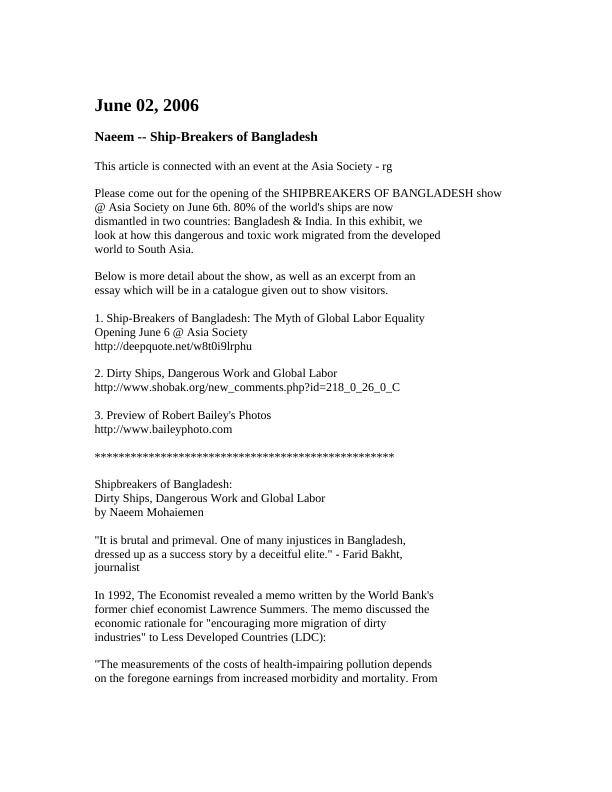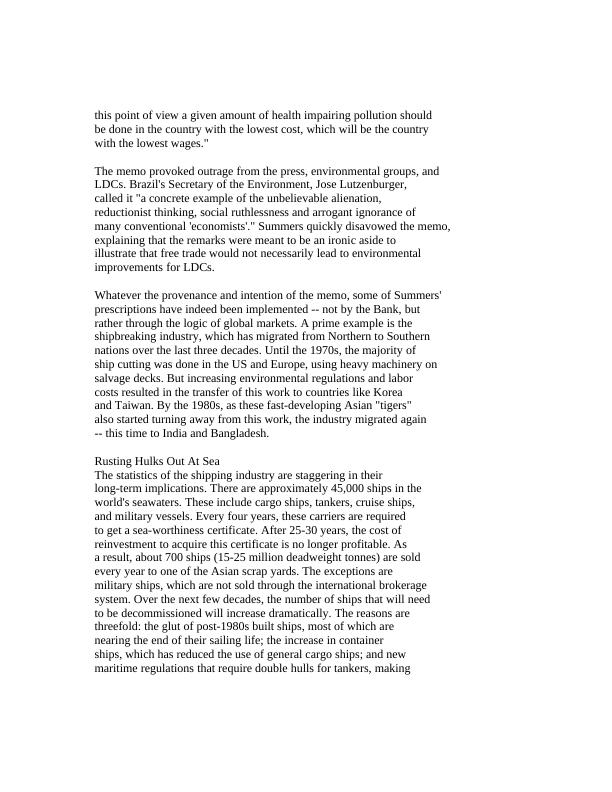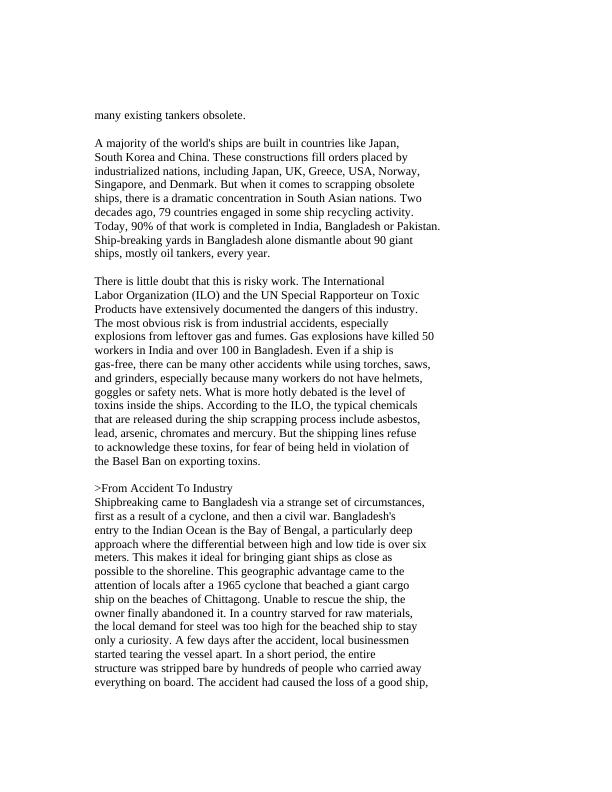Ask a question from expert
Naeem -- Ship-Breakers of Bangladesh Assignment
9 Pages3568 Words279 Views
Added on 2019-09-20
Naeem -- Ship-Breakers of Bangladesh Assignment
Added on 2019-09-20
BookmarkShareRelated Documents
June 02, 2006Naeem -- Ship-Breakers of BangladeshThis article is connected with an event at the Asia Society - rgPlease come out for the opening of the SHIPBREAKERS OF BANGLADESH show@ Asia Society on June 6th. 80% of the world's ships are nowdismantled in two countries: Bangladesh & India. In this exhibit, welook at how this dangerous and toxic work migrated from the developedworld to South Asia. Below is more detail about the show, as well as an excerpt from anessay which will be in a catalogue given out to show visitors.1. Ship-Breakers of Bangladesh: The Myth of Global Labor EqualityOpening June 6 @ Asia Societyhttp://deepquote.net/w8t0i9lrphu2. Dirty Ships, Dangerous Work and Global Laborhttp://www.shobak.org/new_comments.php?id=218_0_26_0_C3. Preview of Robert Bailey's Photoshttp://www.baileyphoto.com**************************************************Shipbreakers of Bangladesh:Dirty Ships, Dangerous Work and Global Laborby Naeem Mohaiemen"It is brutal and primeval. One of many injustices in Bangladesh,dressed up as a success story by a deceitful elite." - Farid Bakht,journalistIn 1992, The Economist revealed a memo written by the World Bank'sformer chief economist Lawrence Summers. The memo discussed theeconomic rationale for "encouraging more migration of dirtyindustries" to Less Developed Countries (LDC):"The measurements of the costs of health-impairing pollution dependson the foregone earnings from increased morbidity and mortality. From

this point of view a given amount of health impairing pollution shouldbe done in the country with the lowest cost, which will be the countrywith the lowest wages."The memo provoked outrage from the press, environmental groups, andLDCs. Brazil's Secretary of the Environment, Jose Lutzenburger,called it "a concrete example of the unbelievable alienation,reductionist thinking, social ruthlessness and arrogant ignorance ofmany conventional 'economists'." Summers quickly disavowed the memo,explaining that the remarks were meant to be an ironic aside toillustrate that free trade would not necessarily lead to environmentalimprovements for LDCs.Whatever the provenance and intention of the memo, some of Summers'prescriptions have indeed been implemented -- not by the Bank, butrather through the logic of global markets. A prime example is theshipbreaking industry, which has migrated from Northern to Southernnations over the last three decades. Until the 1970s, the majority ofship cutting was done in the US and Europe, using heavy machinery onsalvage decks. But increasing environmental regulations and laborcosts resulted in the transfer of this work to countries like Koreaand Taiwan. By the 1980s, as these fast-developing Asian "tigers"also started turning away from this work, the industry migrated again-- this time to India and Bangladesh.Rusting Hulks Out At SeaThe statistics of the shipping industry are staggering in theirlong-term implications. There are approximately 45,000 ships in theworld's seawaters. These include cargo ships, tankers, cruise ships,and military vessels. Every four years, these carriers are requiredto get a sea-worthiness certificate. After 25-30 years, the cost ofreinvestment to acquire this certificate is no longer profitable. Asa result, about 700 ships (15-25 million deadweight tonnes) are soldevery year to one of the Asian scrap yards. The exceptions aremilitary ships, which are not sold through the international brokeragesystem. Over the next few decades, the number of ships that will needto be decommissioned will increase dramatically. The reasons arethreefold: the glut of post-1980s built ships, most of which arenearing the end of their sailing life; the increase in containerships, which has reduced the use of general cargo ships; and newmaritime regulations that require double hulls for tankers, making

many existing tankers obsolete.A majority of the world's ships are built in countries like Japan,South Korea and China. These constructions fill orders placed byindustrialized nations, including Japan, UK, Greece, USA, Norway,Singapore, and Denmark. But when it comes to scrapping obsoleteships, there is a dramatic concentration in South Asian nations. Twodecades ago, 79 countries engaged in some ship recycling activity. Today, 90% of that work is completed in India, Bangladesh or Pakistan.Ship-breaking yards in Bangladesh alone dismantle about 90 giantships, mostly oil tankers, every year.There is little doubt that this is risky work. The InternationalLabor Organization (ILO) and the UN Special Rapporteur on ToxicProducts have extensively documented the dangers of this industry. The most obvious risk is from industrial accidents, especiallyexplosions from leftover gas and fumes. Gas explosions have killed 50workers in India and over 100 in Bangladesh. Even if a ship isgas-free, there can be many other accidents while using torches, saws,and grinders, especially because many workers do not have helmets,goggles or safety nets. What is more hotly debated is the level oftoxins inside the ships. According to the ILO, the typical chemicalsthat are released during the ship scrapping process include asbestos,lead, arsenic, chromates and mercury. But the shipping lines refuseto acknowledge these toxins, for fear of being held in violation ofthe Basel Ban on exporting toxins.>From Accident To IndustryShipbreaking came to Bangladesh via a strange set of circumstances,first as a result of a cyclone, and then a civil war. Bangladesh'sentry to the Indian Ocean is the Bay of Bengal, a particularly deepapproach where the differential between high and low tide is over sixmeters. This makes it ideal for bringing giant ships as close aspossible to the shoreline. This geographic advantage came to theattention of locals after a 1965 cyclone that beached a giant cargoship on the beaches of Chittagong. Unable to rescue the ship, theowner finally abandoned it. In a country starved for raw materials,the local demand for steel was too high for the beached ship to stayonly a curiosity. A few days after the accident, local businessmenstarted tearing the vessel apart. In a short period, the entirestructure was stripped bare by hundreds of people who carried awayeverything on board. The accident had caused the loss of a good ship,

End of preview
Want to access all the pages? Upload your documents or become a member.